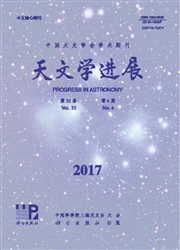

 中文摘要:
中文摘要:
由于星际尘埃的广泛存在和其在恒星与行星系统的形成、星系以及整个宇宙演化中的重要作用,星际尘埃的研究成为当今天体物理领域的热点前沿课题。该文从尘埃与电磁场相互作用的观测证据出发,系统地介绍了星际消光(包括吸收和散射)、星际红外辐射、星际偏振等的研究现状,讨论了星际元素减损,以及行星际尘埃和陨石中的前太阳尘埃等问题。从相应的观测证据中,可以得到关于星际尘埃的丰度、化学组成、尺寸和形状的信息。该文还对当前比较流行的三种尘埃模型(硅酸盐-石墨-PAHs模型、硅酸盐核碳有机耐熔质壳层模型和多孔尘埃模型)进行了讨论与比较,对该研究领域中待解决的问题也作了简要的概括。
 英文摘要:
英文摘要:
Interstellar grains reveal their presence in the space between stars through their interaction with the electromagnetic radiation: they absorb, scatter, redden and polarize starlight, luminesce in the far-red, and emit the absorbed energy at longer wavelengths (i.e. infrared and submillimeter). In this review we present an overview of our current knowledge about the absorption, scattering, polarization, luminescence and infrared emission properties of interstellar dust. Indirect evidence for the presence of interstellar dust including the interstellar elemental depletion and presolar grains in interplanetary dust particles and in meteorites is also discussed. A comparative review of the current popular grain models (i.e. the silicate-graphite-PAHs model, the silicate core-carbonaceous organic refractory mantle model, and the composite model) is also presented.
 同期刊论文项目
同期刊论文项目
 同项目期刊论文
同项目期刊论文
 Determinations of Temperature and Density for Solar-like Stars Using Si XI Soft X-Ray Emission Lines
Determinations of Temperature and Density for Solar-like Stars Using Si XI Soft X-Ray Emission Lines High Resolution Spectroscopy of Halo Stars in the Near UV and Blue Region I. Spectra in the Waveleng
High Resolution Spectroscopy of Halo Stars in the Near UV and Blue Region I. Spectra in the Waveleng Coronal Density Diagnostics with Si X: Chandra LETGS Observations of Procyon, alpha Centauri A and B
Coronal Density Diagnostics with Si X: Chandra LETGS Observations of Procyon, alpha Centauri A and B Electron impact collision strengths and oscillator strengths for Ge-, Ga-, Zn-, Cu-, Ni-, and Co-lik
Electron impact collision strengths and oscillator strengths for Ge-, Ga-, Zn-, Cu-, Ni-, and Co-lik 期刊信息
期刊信息
